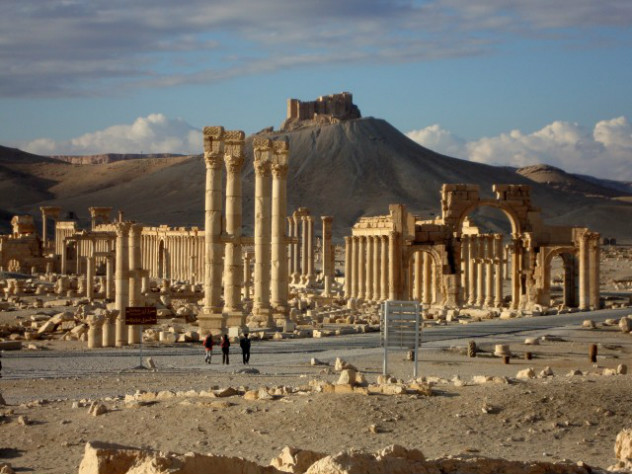8. Palmyra
8.巴爾米拉(Palmyra)
Trade has always been a great source of wealth and knowledge for human civilization. Cities like Palmyra (“place of palms”), situated in the desert of present day Syria, are perfect examples. Built by the Romans when they seized control of the region in the first century AD, Palmyra acted as a central hub for trade within the Silk Road network.
貿易一直是人類文明的遺產和知識的主要來源。像巴爾米拉(Palmyra又譯:帕爾米拉Place of palms:棕櫚樹之城)這樣坐落在沙漠里的城市(如今的敘利亞所在地),就是完美的例證。公元1世紀,羅馬人控制這片地區的時候建立了巴爾米拉,那時的巴爾米拉是古絲綢之路上最繁榮、最有文化底蘊的一座綠洲城市,也是地中海地區和古代東方的貿易中轉站。

All goods coming to the West from China and India went through this city, which charged the traders as much as 25% for this privilege. Palmyra offered in return security, water, food, shelter and shade for travelers who were happy to pay to have access. Its design and architecture show the mercantile nature of the city — by connecting the Temple of Ba’al, Diocletian’s Camp, the Theater and the Agora with colonnaded streets some 1100 meters long, shade was provided for all sorts of traders and craftsmen.
所有中國和印度的商品要運輸到西方都必須經過巴爾米拉,于是巴爾米拉便收取貿易者25%的中轉費。當然,作為回報,巴爾米拉也會替支付中轉費的商隊保護貨物的安全,為商隊提供水,食物,暫住居所以及乘涼的蔭蔽。這座城市的設計和建筑也彰顯了它的商業性質——用大概1100米長的廊柱街道連接起巴力寺(Temple of Ba’al),戴克里先營(Diocletian’s Camp),劇院和集市,為來往的商人和工匠們提供蔭蔽。
Palmyra had been a semi-independent city state influenced by Roman rule. When the city’s ruler, Odaenathus, was assassinated, his wife Zenobia came to power. Under her dominion, the city began to expand its rule throughout the Middle East, triggering a conflict with Rome. After Zenobia’s defeat and capture in 272 AD, she was paraded in golden shackles by Emperor Aurelian through the city of Rome, while Palmyra was sacked and never truly recovered.
巴爾米拉曾是羅馬帝國統治下的一個享有自治權的城市。巴爾米拉的統治者,奧登納圖斯(Odaenathus)被暗殺后,他的妻子塞諾維婭(Zenobia)掌權。在她的帶領下,巴爾米拉開始拓展在整個中東地區的統治,從而引發了與羅馬的沖突。塞諾維婭戰敗并于公元272年被捕,她被皇帝奧勒利安(Aurelian)用金鎖鏈銬著在羅馬城中游行,從此巴爾米拉就被遺棄了,并且再也不復往日的繁榮。











